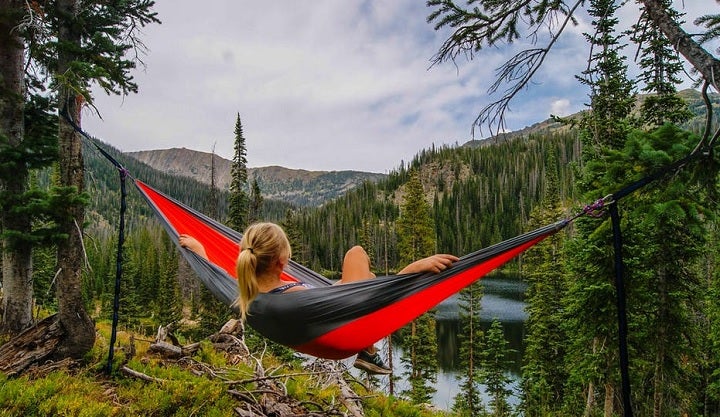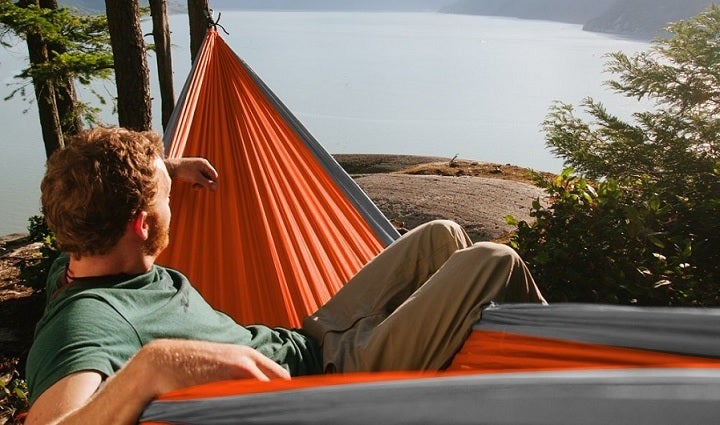
Our Editors independently research, test, and rate what we feel are the best products. We use affiliate links and may receive a small commission on purchases.
Quick Answer: The 7 Best Rated Camping Hammocks
- Night Cat Camping Hammock Tent
- Hammock Bliss No-See-Um No More
- Lawson Hammock Blue Ridge Camping Hammock
- Oak Creek Lost Valley Camping Hammock
- Kammok Roo Camping Hammock
- Grand Trunk Double Hammock
- Fox Outfitters Neolite Double Camping Hammock
Our guide and comparison table of the top rated camping hammocks will help you choose the right hammock for you.
Best Camping Hammocks
Now we’ll take a closer look at the various types of hammocks and their features to help you decide which one is right for your needs. Lets get to it!
Best Camping Hammocks With Bug Netting
#1 Night Cat Camping Hammock
- Weight: 4 Pounds
- Capacity: 440 Pounds
- Rainfly: Yes
- Bug Net: Yes
The Night Cat is not the lightest hammock on our list but we would have to say it’s the most comfortable! It weighs just over 4 pounds and folds down into the included stuff sack to about 16″ long by 6″ wide.
What sets the Night Cat apart from most hammocks is the versatility and the spreader bars.
Aluminum alloy bars keep the hammock from collapsing around you like a banana which is the problem with most camping hammocks.
This allows you to sleep on your side or back and if you want to get even more comfortable, use an inflatable mat.
I love that the insect net is built in so there is nothing extra to attach or lose. The downside is there will be slightly less ventilation but being able to sleep without being attacked by mosquitos is worth it! It also comes with a waterproof rain fly that can help protect you from the elements.
#2 Hammock Bliss No-See-Um No More
- Weight: 28 ounces
- Capacity: 350 lbs
- Rainfly: No
- Bug Net: Yes
There’s nothing particularly complicated about the design of a hammock. That’s why reinventing the wheel just isn’t always necessary. In this case, Hammock Bliss comes in with a bug net hammock that’s affordable and versatile.
If you’re on the lookout for a simple hammock that you can use in a variety of situations, pay attention. Hammock Bliss has brought to market this simple nylon and bug net hammock that’s lightweight and effective.
At 1 pound 12 ounces it’s not the lightest out there, but it’s not bad either. Pair this with a lightweight rainfly and you’ve got a pretty minimalist backpacking setup, actually!
One thing I like about this particular design is that it forgoes a ridgeline and instead suspends the bug net with tie-outs.
This might seem like a hassle, but it allows you to flip the hammock upside down and use it without the bug net if you want a traditional open hammock. Why didn’t I ever think about this!?
Best for users who don’t always want a bug net hanging above them.
Best Hammock Tent
#3 Lawson Hammock Blue Ridge Camping Hammock
- Weight: 68 ounces
- Capacity: 275 lbs
- Rainfly: Yes
- Bug Net: Yes
If you hate being folded up inside your hammock like a big ol’ bear burrito you might want to consider a bridge hammock like the Lawson Blue Ridge. In a lot of ways it’s like a tent hung between two trees – and who doesn’t want that???
Before we go any further I’d like to make sure you know what a bridge hammock is. These hammocks use spreader bars at the front and back to evenly distribute the weight of the sleeper across the hammock. This creates a flat lying position and “tent-like” feel.
Despite Lawson’s attempts to brand it as “the most versatile tent hammock in the world”, bridge hammocks are nothing new to the world of backpacking.
That said, it is a great option for car camping, paddle camping, and more! With a total weight of 4.25 pounds, however, it’s hardly a lightweight option for backpackers.
One of the cooler features is that you can stake out this hammock/tent on the ground if you can’t find a tree to swing from! This is, perhaps, one of the biggest reasons to consider using a free-standing bridge hammock.
Don’t forget that you’ll have to buy the tree straps separately (and you’ll want them)! I will say that for a product branded as a hammock/tent the fact that it doesn’t come with tree straps seems really stupid to me.
However, the bug net is included in the hammock itself so you’re ready to go on good-weather days.
Best for versatile hammock and tent use on trips where weight and bulk aren’t a big concern.
Best Camping Hammock With Rain Fly
#4 Oak Creek Lost Valley Camping Hammock
- Weight: 64 ounces
- Capacity: 350 lbs
- Rainfly: Yes
- Bug Net: Yes
When we start lining up our sights on affordable camping hammock packages, it’s impossible to ignore this one. Oak Creek gives you everything you need to get started hanging and it comes in a beginner-friendly package.
Alright, so you’re stoked about hammock camping. You’ll need tree straps, a hammock, a rainfly, and that’s about it. Fortunately, that’s exactly what you get here! Though it doesn’t count as lightweight in my book, it is a turn-key package that’s a good option to get you started.
Maybe my only complaint about this hammock is that we don’t get any details about the rainfly. If I’ve learned anything over the years about inexpensive backpacking shelters, it’s that waterproof gear has a tendency not to be so waterproof.
That said, it’s easy to do some seam sealing yourself if needed by following this tutorial. At the end of the day, at least you’ll be bug-free thanks to the built-in mosquito net.
If you’ve never tried hammock camping before, I recommend giving it a try in the backyard before you take it on a trip. There’s a lot to learn and you’ll probably make a mistake or two!
Best for beginners looking to get a package that’s ready to go at a very affordable price.
#5 Kammok Roo Camping Hammock
- Weight: 18 ounces
- Capacity: 500 lbs
- Rainfly: No
- Bug Net: No
The Roo who designed these is obviously a climber – or appealing to climbers. If you like hanging from trees in colorful hammocks with climbing carabiners and slings then you’ll be right at home nestled into this cocoon!
These hammocks remind me a lot of the Eno Double Nest hammocks and they’re at a very similar price.
We can’t really compare this to other camping hammocks apples for apples, however, for one main reason. This hammock has no rain fly or bug net while most others on our list have one or the other.
I really like the carabiners and slings included with this hammock. They’re probably overkill, but unlike some other hammocks I don’t see any reason to worry about durability and longevity.
Best for recreational hammock use or areas where bugs are minimal.
Best Double Camping Hammock
#6 Grand Trunk Double Hammock
- Weight: 21.6 ounces
- Capacity: 400 lbs
- Rainfly: No
- Bug Net: No
Grand Trunk has been showing us some quality camping hammocks for a while now. Are they comparable or better than the competition on our list? That’s the question.
Ready to use out of the box, the hammock comes with tree straps, carabiner, and carrying case. If I had to dock it points, though, I’d say the tree straps should be webbing instead of rope. Rope can damage trees over time while webbing is usually safer on trees.
This hammock is a double size hammock which means you can snuggle up together. Some people use a double hammock solo and take advantage of the extra material to wrap around themselves at night – like an improv bug net!
With no less than 23 different dual color options, there has got to be something for you.
Keep in mind that it’s pretty inexpensive to get a rainfly to add on with this hammock which will turn it into an all-weather camping hammock. Just check out the Wise Owl Hammock Tarp above.
Pro Tip: Don’t try to sleep with two people in a hammock – it’s wildly uncomfortable and you’ll hate your partner by the morning.
Best Backpacking Hammock
#7 Fox Outfitters Neolite Double Camping Hammock
- Weight: 19 ounces
- Capacity: 400 lbs
- Rainfly: No
- Bug Net: No
Fox Outfitters comes in with a jab at the double hammock market. What sets these apart from the rest, though? In my opinion they’ve got one notable difference you’ll want to mull over.
It’s worth saying here that the Fox Outfitters Neolite Double takes the prestigious “Lightweight Award’! Okay, I made that award up – but it is the lightest hammock on our list!
That statistic might be a bit skewed, however, because of the lack of rainfly and bug net. It’s still the lightest double hammock we’ve looked at so if weight is a major consideration for you then the buck stops here.
Ironically, not only is it the lightest, it’s also the cheapest!
On top of that I personally like the tree straps (sometimes called tree huggers) on this hammock better than any others on our list.
While the hammock straps are still rope, they run through protective nylon sleeves which spread out the force and abrasion of the straps to prevent damage to the trees. Nice!
Best for a couple who want a backpacking hammock while saving money at the same time!
Camping Hammock Comparison Table
| Camping Hammock | Weight Capacity | Dimensions | Hammock Weight | Mosquito Netting | Rainfly | |
|---|---|---|---|---|---|---|
| Night Cat Camping Hammock | 440 lbs | 8'9" L x 4'6" W | 4 lbs | Yes | Yes | |
| Hammock Bliss | 350 lbs | 9'10"L x 4'10"W | 28 oz | Yes | No | |
| Lawson Blue Ridge Hammock | 275 lbs | 7.5"L x 4"W | 68 oz | Yes | Yes | |
| Oak Creek Hammock | 360 lbs | 9'L x 4'6"W | 48 oz | Yes | Yes | |
| Kammok Roo Hammock | 500 lbs | 10'L x 5'5"W | 18 oz | No | No | |
| Grand Trunk Hammock | 400 lbs | 10'6"L x 6'6"W | 21 oz | No | No | |
| Fox Outfitters Neolite Double | 400 lbs | 10'6"L x 6'6"W | 19 oz | No | No |
How to Choose the Best Camping Hammock for You
Hammock Materials
Nylon
Nylon is a manmade fabric that is super durable! Originally used in parachutes, nylon may be the most popular fabric of choice for today’s colorful hammocks.
Nylon also can be made into ripstop which is just a weave of thicker, stronger fibers that cross through the fabric. Ripstop nylon can vary wildly in strength, color, pattern, and usage.
All nylon fabrics are rated by denier which denotes the thickness. Higher denier is stronger but also heavier to carry and usually less supple against the skin.
Polyester
Similar to nylon in many respects this manmade fiber comes in many deniers and can also be made into ripstop weaves.
Polyester is known to be a little less abrasion resistant than nylon. What it does have going for it, however, is that polyester tends to breathe better than nylon and usually feels a little less “plasticy”.
Either material is a fine choice for a hammock, assuming it has been properly crafted.
Rainfly Materials
In the world of hammock camping, tarps or rainflys can come in many different materials. Silicone impregnated polyester or nylon, however, tends to be the fabric of choice.
Just like normal nylon and poly weaves, silnylon and silpoly also come in various thicknesses. For rainflys a 10D – 20D fabric is usually just fine!
Rainflys can also be made from some space-age materials like mylar laminate or cuben fiber. This cray lightweight material is hyper expensive and prone to puncture damage. Because it weighs fractions of what other fabrics do, however, it is a material of choice for ultralight purists.
Seam Waterproofing
Camping hammocks need tarps unless you want to wake up soaked (which can be dangerous). Most hammock tarps are sewn with a seam at the ridge. This seam must then be sealed after it has been sewn as the needle holes and thread act as conduits to let rain in where it will drip on your face all night long. Bummer!
Seam sealing comes in basically three flavors.
Seam Tape
Seam tape is applied with heat in the factory where pressure is added to bond a plastic laminate to the seam. This seam tape then becomes waterproof and prevents leaks at the seams.
Seam tape is notorious for only lasting a handful of seasons before eventually coming off. The better care you take of your gear, however, the longer this seam tape may last.
When it does come off you’ll have to repair it with the following method…
Seam Sealing
Using diluted silicone you can seal the seams of your tent or tarp to prevent leaks or repair them. This video shows you how to do it!
I personally find this to be a great way to seal seams on silnylon and silpoly! Once you learn to do it your seams will be more reliably waterproof and you’ll know how to fix it in a jiffy!
Welded Seams
Bonded, or welded, seams are those that have been chemically adhered to one another at a molecular level. This is a stronger and more reliable method of seam sealing than any other!
Unfortunately, this method is not possible on silnylon or silpoly (the most popular waterproof fabrics).
Seam welding can only be done on certain materials, among them cuben fiber. Becuase the two pieces of fabric are joined by heat or sonic welding there is no thread involved in creating the seam. Thus there are no holes and the resulting seam is actually stronger than the surrounding material. Just like a metal weld.
Tree Straps
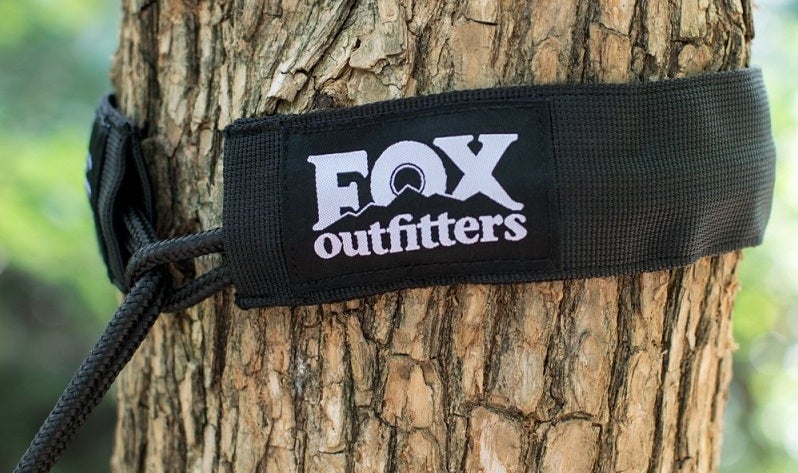
There are about two ways this tends to fall.
Either your hammock uses ropes as tree straps or it uses webbing.
Webbing is flat tubular fabric often used in industrial rigging and climbing. It can handle a lot of weight! One of the great things about webbing is that the most common size 1” webbing spreads the abrasion from your hammock out on the tree bark.
Some parks require 1” tree straps just to hang your hammock. Ropes do serious and permanent damage to trees – particularly smaller trees or those with soft bark.
Don’t worry, even if you have ropes with your hammock, chances are very good that you can use some knots, a carabiner, and some webbing or slings to make your hammock gentler on the trees!
I used the 11’ versions of these bad boys from Pro Hammock for mine. Don’t do what I did, though! I ran mine over with the lawnmower…
Stakes
If you’re rocking an asymmetrical hammock or a hammock tarp you’ll need stakes to go with it. Sometimes you can get away with tying out to limbs, rocks, roots, or branches but don’t count on it all the time.
I personally use and recommend the MSR Groundhog stakes since they’re light, durable, and provide the best hold of any stake I’ve used in all soil conditions.
Size and Weight Capacity
I have to admit that trying to sleep with two people in a hammock just blows. Don’t do it.
That said, enjoying reading a book or watching the sunset from your hammock can be fun together! These are the times when sharing a hammock really shines.
Hammocks usually get sized as solo or duo hammocks. Of course, sizing can be very precise and some cottage industry manufacturers actually allow you to pick the length and width of your hammock.
For the most part, I feel that an 11’ hammock is about the sweet spot for most people. Shorter hammocks are lighter, but the longer hammock allows a bit flatter lay.
When calculating weight capacity, don’t go too low! Remember that your gear and anything you put in the hammock adds weight. I’d try to stay 25 – 50 pounds under the load limit as a rule of thumb.
Hammock Types
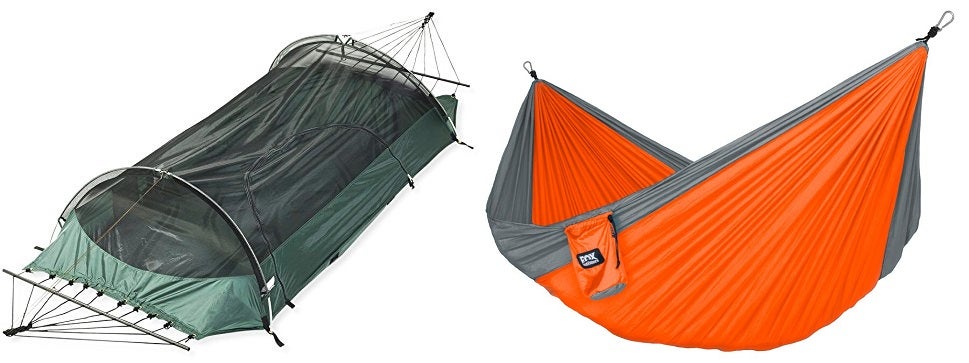
Traditional Hammocks
These hammocks are the standard bannana shape that you’re used to. You lay in them inline with the ropes along the longest axis of the hammock itself. Often these are also called gathered-end hammocks.
Doing so causes a very U shaped lie when hanging which is uncomfortable for many. While it feels great at first, most people don’t like to sleep this way overnight.
Asymmetrical Hammocks
These hammocks resemble traditional hammocks at a glance. They’re hung the same way and lack any spreader bars.
In an asymmetrical hammock the fabric is layed out in such a way as to promote an off-kilter lay. You actually lay at a slight angle to the hammock’s longest axis with your head off one side of midline and your feet off the other.
This causes a much flatter lay than a traditional hammock and most popular camping hammocks tend to favor this style. Using a hammock designed for two people often results in enough excess material to permit a very similar lie when done right.
Bridge Hammocks
With this hammock style you have the iconic spreader bar at the head and foot of the hammock. This is done to make the hammock look flatter and lie flatter.
The end result of these bridge hammocks tends to be a massive reduction in stability. Many people blame this for the hammock flipping incidents that seem so commical.
Bridge hammocks are less common for camping and backpacking because the bridge bars are bulky and heavy. Most campers find that the percieved benefit of a flatter lie is not worth the additionale hassle and weight that comes from carrying and using bridge hammocks.
I encourage you to borrow one and try it before you buy – maybe it’s just the right thing for you!
Bug Nets
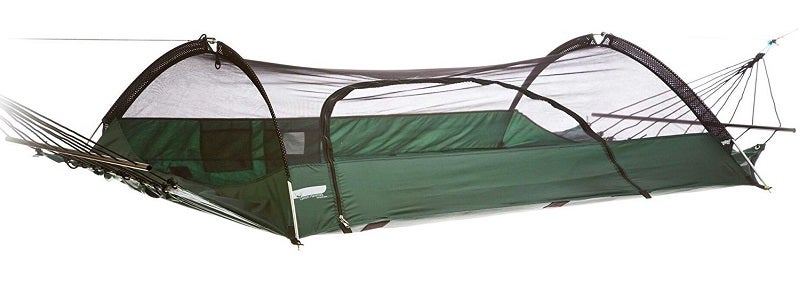
For me, a bug net is a must-have item on a camping hammock. If you happen to live and camp in an area with no biting insects, maybe you can get away without it.
Don’t be tempted into thinking that you can wear a bug net face protector – it’s just not worth it. Sure, I guess it’s possible you could do it but I think the majority of us just won’t be able to get a good night’s sleep with a bug net crowding our face inside the hammock.
Instead, just go with the few extra ounces it takes to get a hammock that has bug netting already installed! It gives you enough room to move around and sleep comfortably without worrying about getting your blood sucked dry!
FAQs About Camping Hammocks
Q: Can I make my own camping hammock?
A: Totally! A gathered end hammock is really simple to make.
If you want to save money, however, think again! Buying the huge amounts of nylon fabric you need to make a gathered end hammock will end up costing you about as much as just buying a cheap one to begin with!
However, if you want the experience or you want a hammock that’s totally unique then consider sewing a gathered end hammock like this guide expains!
I’ve tried making my own backpacking gear several times and each time I end up spending more time and money by the completion of the project than I would have if I’d just bought something to begin with…
Q: Which type of hammock is the most comfortable to sleep in?
A: A good bridge hammock may be the most comfortable. They provide the flattest lay and the best sleep for me.
However, considering the drawbacks and stability issues of many bridge hammocks, a good asymettrical hammock makes a great second choice.
For me I avoid traditional gathered end hammocks because I don’t like the U shaped lie. It feels good for a while, but overnight laying in that U bend shape is uncomfortable for me.
Whenever you can I always recommend borrowing a hammock to try for the night before you buy one. That’s the best way to save money and make smart buying choices. This tip applies to all backpacking gear really!
Pro Tip: Ask other hikers about the gear when you see them at the campground or on the trail! Most people are happy to talk about their gear so prepare to hear everything!
Q; Are hammocks allowed in all areas?
A: NO!
Hammocks are actually not allowed in all areas or campgrounds. One area that comes to mind is the Great Smoky Mountains National Park which does not allow hammock camping.
Many places that do allow hammock camping require that you use 1” straps for the trees. We talked about this earlier, but remember that those 1” straps do less damage to the trees.
Even if wide straps aren’t required for your area, you should still use them to protect the trees we all enjoy using!
Q: Are hammocks cold to sleep in?
A: Yes.
Hammocks fall victim to something called convective heat loss. Air moving under and around the hammock whisk away your heat and warmth, particularly as cold evening winds whip up. In a tent you use a sleeping pad to insulate yourself from ground temperatures. In a hammock things work differently.
For hammock sleepers you’ll need an underquilt. These poofy sleeping-bag-like pads keep you warm and protect from moving cold winder under the hammock.
In warm climates you can get away without an underquilt. If temperatures are up around 70 at night then an underquilt is probably not necessary and the added cooling can be a welcome relief.
To attach your under quilt to the hammock you’ll need some clips and straps. Before you buy a hammock make sure it has clips for a quilt if you plan to use one.
Q: Can I use a hammock without trees?
A: There are hammock stands that you can use! These are great for campgrounds if you can carry the stands in with your truck or car. Hammock stands are way to big and bulky for hiking though.
For other situations you’ll need a hammock that can be setup on the ground. On our list there is the Lawson Blue Ridge hammock which works great without trees! It’s designed to operate as a standalone unit.
Most hammocks, however, cannot be used without a tree. Sad face.
Tips on Setting up a Camping Hammock
Final Thoughts
At the end of the day hammocks are a great way to enjoy camping. Whether you use them for sleeping or hanging our during the day, they’re a welcome retrieve from laying on the ground.
Exactly what hammock is right for you must be determined by your preferences. Are you hiking with your hammock? Do you need rain protection? Would you like enough room for your partner to hang with you?
All of these determine which hammock you need to take out with you on your next trip. Revisit our “buyer’s guide” section and then you’ll be ready to choose the best hammock for camping!

